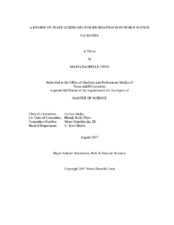| dc.description.abstract | Quality recreation programs have been shown to strengthen protective factors in youth to mitigate risk factors, ultimately improving youth outcomes and reducing juvenile delinquency. How recreation is employed within this unique setting has been unknown until this point. This study is the first step to understanding how recreation programs can enhance the rehabilitative efforts of the juvenile justice system by reviewing the legislative and administrative regulations related to recreation practices in juvenile justice facilities in the United States. The research questions that were asked include: 1) whether or not a legislative and/or administrative authority exists that governs a minimum amount of recreation time for youth in juvenile justice facilities (including the type of written authority and how recreation is defined), 2) the type, frequency, location and length of recreation allowed for youth while in confinement, and 3) the circumstances in which youth can be denied access to recreation.
A systematic review of the written authorities was conducted by searching state websites, legal and government databases. A survey was developed to capture archival data elements and utilized to review the documents. Among other discoveries, we found that seven different types of written authorities exist, and only 40% of states include a purpose for the recreation services that are offered to youth in confinement. We found that the terms recreation, leisure and exercise are used interchangeably and 70% of states require that recreation is available to youth on a daily basis. The results of this investigation present implications for policy-makers, recreation professionals and the public alike. These include the need to advocate for the provision of recreation services in the juvenile justice system, establishing an appropriate minimum standard for recreation programs in juvenile justice, and communicating the positive impact recreation programs can have for youth and the community. | en |


